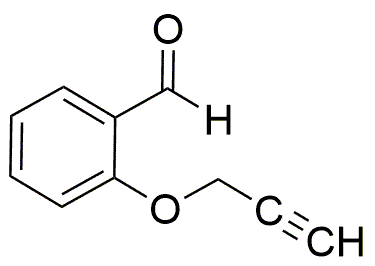2-(Prop-2-yn-1-yloxy)benzaldehyde is widely utilized in research focused on:
- Synthesis of Fine Chemicals: This compound serves as an important intermediate in the synthesis of various fine chemicals, including pharmaceuticals and agrochemicals, due to its unique reactive properties.
- Organic Synthesis: It is commonly used in organic synthesis reactions, particularly in the formation of complex molecules, making it valuable for researchers in the fields of medicinal chemistry and materials science.
- Fluorescent Probes: The compound can be employed in the development of fluorescent probes, which are essential in biological imaging and diagnostics, enhancing visibility and specificity in research applications.
- Polymer Chemistry: It finds applications in polymer chemistry, where it can be used to modify polymer properties, leading to materials with enhanced performance in industries such as packaging and coatings.
- Research on Antimicrobial Agents: Researchers are exploring its potential as a precursor for antimicrobial agents, contributing to the development of new treatments in the pharmaceutical industry.
Informations générales
Propriétés
Sécurité et réglementation
Applications
2-(Prop-2-yn-1-yloxy)benzaldehyde is widely utilized in research focused on:
- Synthesis of Fine Chemicals: This compound serves as an important intermediate in the synthesis of various fine chemicals, including pharmaceuticals and agrochemicals, due to its unique reactive properties.
- Organic Synthesis: It is commonly used in organic synthesis reactions, particularly in the formation of complex molecules, making it valuable for researchers in the fields of medicinal chemistry and materials science.
- Fluorescent Probes: The compound can be employed in the development of fluorescent probes, which are essential in biological imaging and diagnostics, enhancing visibility and specificity in research applications.
- Polymer Chemistry: It finds applications in polymer chemistry, where it can be used to modify polymer properties, leading to materials with enhanced performance in industries such as packaging and coatings.
- Research on Antimicrobial Agents: Researchers are exploring its potential as a precursor for antimicrobial agents, contributing to the development of new treatments in the pharmaceutical industry.
Documents
Fiches de données de sécurité (FDS)
La FDS fournit des informations de sécurité complètes sur la manipulation, le stockage et l’élimination du produit.
Spécifications du produit (PS)
Le PS fournit une description complète des propriétés du produit, notamment sa composition chimique, son état physique, sa pureté et les exigences de stockage. Il détaille également les plages de qualité acceptables et les applications prévues du produit.
Certificats d'analyse (COA)
Recherchez des certificats d'analyse (COA) en saisissant le numéro de lot du produit. Les numéros de lot et de lot se trouvent sur l'étiquette d'un produit, après les mots « Lot » ou « Lot de fabrication ».
Numéro de catalogue
Numéro de lot/série
Certificats d'origine (COO)
Ce certificat d'exploitation confirme le pays dans lequel le produit a été fabriqué, et détaille également les matériaux et composants utilisés et s'il est issu de sources naturelles, synthétiques ou autres sources spécifiques. Ce certificat peut être requis pour les douanes, le commerce et la conformité réglementaire.
Numéro de catalogue
Numéro de lot/série
Fiches de données de sécurité (FDS)
La FDS fournit des informations de sécurité complètes sur la manipulation, le stockage et l’élimination du produit.
DownloadSpécifications du produit (PS)
Le PS fournit une description complète des propriétés du produit, notamment sa composition chimique, son état physique, sa pureté et les exigences de stockage. Il détaille également les plages de qualité acceptables et les applications prévues du produit.
DownloadCertificats d'analyse (COA)
Recherchez des certificats d'analyse (COA) en saisissant le numéro de lot du produit. Les numéros de lot et de lot se trouvent sur l'étiquette d'un produit, après les mots « Lot » ou « Lot de fabrication ».
Numéro de catalogue
Numéro de lot/série
Certificats d'origine (COO)
Ce certificat d'exploitation confirme le pays dans lequel le produit a été fabriqué, et détaille également les matériaux et composants utilisés et s'il est issu de sources naturelles, synthétiques ou autres sources spécifiques. Ce certificat peut être requis pour les douanes, le commerce et la conformité réglementaire.


